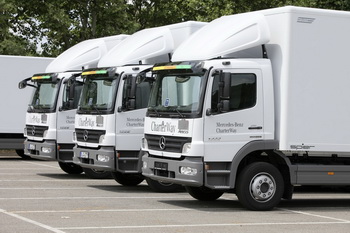
Germersheim, Germany, reported to be located in the centre of Europe was the location chosen by Mercedes-Benz Commercial Vehicles to host a Distribution Symposium. Situated just a few minutes away from its Wörth production plant, the massive warehouse built in the Southern Palatinate region where the event was held also happens to be the Mercedes-Benz Logistics Centre. Attended by European transport journalists, the Conference was mediated by Stefan Schulze-Hausmann, a presenter of transport and science programmes on German TV. He introduced the keynote speaker Sylvia Diederichsmeren, Head of Future Markets & Customers at Daimler AG. Words like conurbations and futurology were mentioned more than once but when she got down to it, the face of urban living is changing and as a consequence so too is urban transportation particularly distribution.
She began by explaining (to the converted) what distribution transport is all about – or her interpretation of it. "Distribution transport is often the pre-or on-carriage part of a long haul transport operation starting from a central depot – the so called Final Mile. Distribution transportation primarily serves the consumption needs of the people who live in conurbations." Let‘s explain what that last word means – "an extended urban area, typically consisting of several towns merging with the suburbs of one or more cities" - so there!
The regular supply to retail outlets from food and drink retailers to clothing and pharmacy stockists together with the increase in internet shopping that requires home deliveries were cited by Sylvia as the main day-to-day operations of urban distribution providers. Another area which is growing due to customer demand, is chilled food and drinks as well as frozen foods which is specialist due to its nature of application. Surprisingly refuse collection or postal deliveries do not form part of this equation according to Sylvia. "Due to the types of goods and sizes of consignments involved, all classes of vehicles participate in distribution transport – from cars, vans to tractor-units with semi-trailers."
This in itself poses a problem and she sees a number of challenges ahead. As increasing numbers of people are moving to urban areas, small and medium-sized towns on the outskirts of cities are growing, while at the same time City Authorities are promoting Inner-City regeneration. United Nations forecasts that the global population will rise to over 60% of the World‘s total population by 2030 and will reach around 70% in 2050. Wonder if these figures are recession proof? But as the old Irish saying goes "there is no poverty under the blankets." Time will tell!
"Creeping mobility", already a reality in many towns and cities today will continue to increase. As a result exhaust emissions and noise pollutions will become more in focus in towns and cities with the aim of improving the quality of life. But what can the Authorities do apart from introducing more Environmental Zones as already in place in London, Stockholm, Bologne and Berlin for example? Weight-Class Regulation, Appointed Delivery Times and certain "No-Go Areas" for heavy traffic, were mentioned by Sylvia as town‘s and City Authorities take on a leading role in climate protection in the future. "Towns will compete for the title of "Greenest Town" and Best Practice projects will be exchanged", she forecasts. But in reality, towns and cities will be unable to fully exclude truck traffic. For instance if a 40 tonne truck were to be replaced by smaller vehicles to supply a supermarket, around 17 vans would be required. There will be a greater emphasis, for sure, on reducing CO2 emissions in urban traffic from here on and this will lead to vehicle manufacturers developing products with low to zero emissions such as diesel-electric hybrids to full electric power. But with a 12-tonne hybrid averaging €45,000 more expensive than the conventional diesel powered equivalent, financial incentives must be offered to transport companies that have to comply with this regulation.
Already some of the larger transport and logistics companies are heading in this eco-friendly manner. DHL for example has set a target to reduce emissions from its own vehicles and its subcontractors by 30% between 2007 and 2020. Along with TNT Express, FedEx and also Coca-Cola, field trials with hybrids and electric vehicles are ongoing across Europe. The ESB, the Irish Electricity Supply Board has a policy as we know in running a fleet of vehicles powered by the energy source it generates hence the purchase of electric/hybrid vehicles from Allied, Smith and Fuso. She concluded by saying that "the changing underlying conditions in the towns and cities will have a major impact on distribution transportation and truck customers operating in this field in the future."
JARLATH SWEENEY
